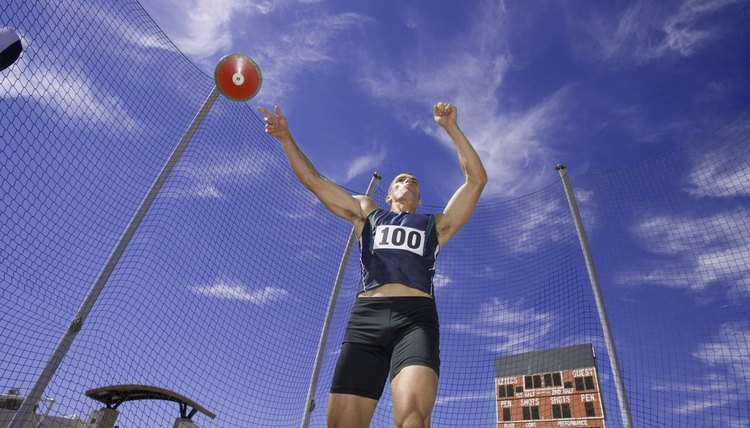Which Muscles Are Used When Throwing a Discus?

The discus throw dates to the ancient Olympics and is depicted in Myron's classic statue "Discobolus" as a symbol of power and strength. Today's modern track and field athlete continues the quest to throw the discus as far as possible. Success in the event requires the ability to generate power from all of the major muscle groups.
Function
Your muscles consist of fast- and slow-twitch fibers that generate force to overcome resistance. Muscles contract and stretch to pull your bones for joint movement and body stabilization. While one group of muscles contract, the opposing muscle group stretches in order for movement to occur. Throwing the discus specifically requires your muscles to exert the most amount of force in the shortest amount of time, thus engaging your fast-twitch fibers, according to the publication "Personal Training Manual."
Lower Body Muscles
During the first phase of the discuss throw, your lower body muscles are emphasized. The starting stance and windup require your body to rotate into a twist. Your hip rotators, consisting of the gluteus, gemellish and obturator muscle groups, along with the pyriformis, rotate your hips and body around a fixed point, according to "Personal Training Manual." Your thigh muscles, the quadriceps and hamstrings, contract to lower and lift your hips and knees to generate power. Your lower leg muscles, the tibialis anterior and gastrocnemius, contract to push your body weight from the surface as you transfer your weight from one leg to the other.
Upper Body Muscles
While your upper body muscles are relatively relaxed during the first part of the movement, they begin to contract during the flight and release phases. In the next phase, your chest is the primary mover as it contracts to bring the discus across your upper body toward the release. Your shoulders and triceps contract to lift and extend your throwing arm. Your forearm, wrist and hand muscles contract to hold and release the discus. Your back and bicep muscles contract as you bring the discus back, then stretch as you extend and release the discus.
Core Muscles
Your core muscles consist of your abdomen and lower back muscles. Success in movements requiring power comes from a strong core. The power generated from your lower body muscles is transferred to your upper body through your core. Contraction of your core muscles stabilize one part of your body while the other part rotates, according to the book "Stronger Abs and Back."
References
Writer Bio
Luann Voza teaches both math and science in an elementary school setting and physical education in a college setting. A former fitness-club owner, Voza has taught group fitness classes in step, aerobics, yoga, Pilates and kickboxing. As a bodybuilder, she held the title of Ms. New Jersey Lightweight Division Winner. Voza has a master's degree in exercise physiology and a doctoral degree in education.
